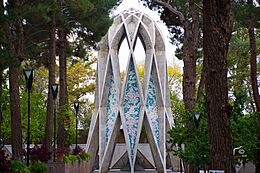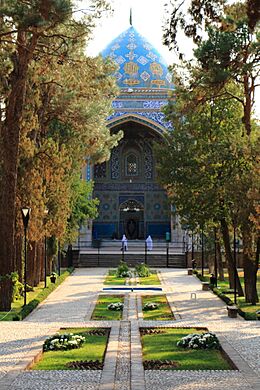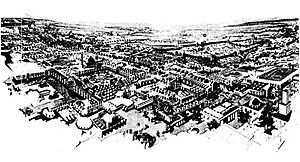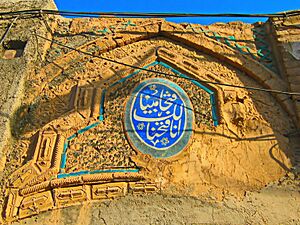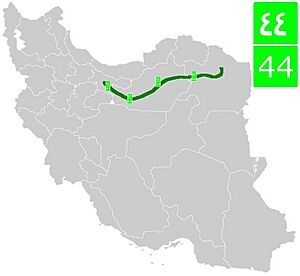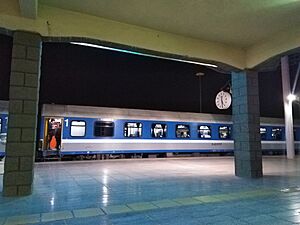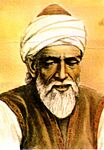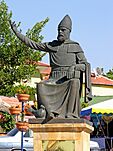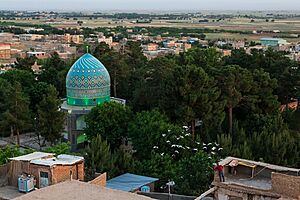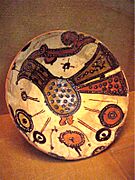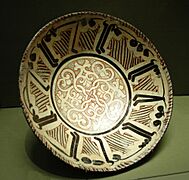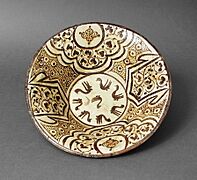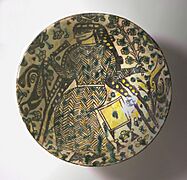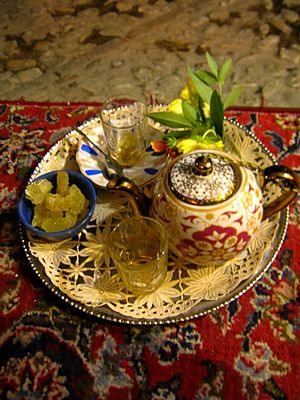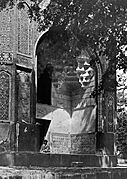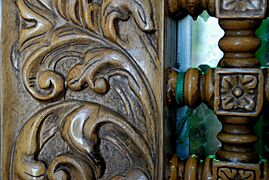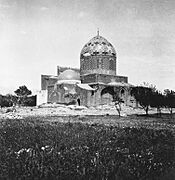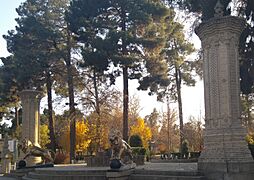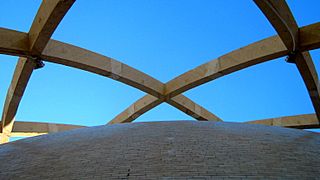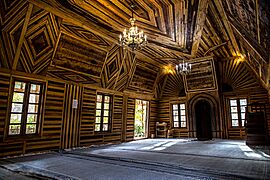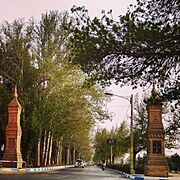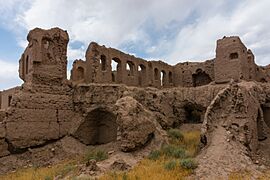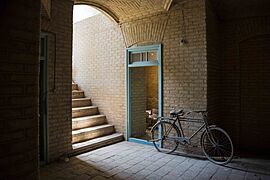Nishapur facts for kids
Quick facts for kids
Nishapur
Persian: نیشابور
Abarshahr (اَبَرشهر), Raēvant (رَئِوَنْت), Shadiyakh (شادیاخ)
|
||
|---|---|---|
|
City
|
||
| Neyshabur | ||
|
From top to bottom & from left to right:
Mausoleum of Omar Khayyám, Shah Abbasi Caravansarai, Mausoleum of Attar of Nishapur, Imamzadeh Mohammad Mahrouq & Khayyam's garden, An archeological discovery of Nishapur, Bagh-e Meli of Nishapur, Khanate Mansion of Amin Islami, Kamal Al-Molk Tomb and the Wooden Mosque of Nishapur. |
||
|
||
| Nickname(s):
Sassanid and Umayyed era: Abarshahr (Upper Cities), Little Damascus (According to Ibn Battuta), The City of Turquoise, The City of Gardens
|
||
| Country | Iran | |
| Province | Razavi Khorasan | |
| County | Nishapur | |
| District | Central | |
| Historical Region | Khorasan | |
| Founded | 5500 B.C. | |
| Municipality of Nishapur | 1931 | |
| Founded by | Shapur I | |
| Government | ||
| • Type | Governorate, Mayor & City Council | |
| Elevation | 1,250 m (4,100 ft) | |
| Population
(2016)
|
||
| • City | 264,375 | |
| Demonym(s) | Nishapuri, Nishaburi or Neyshaburi | |
| Time zone | UTC+03:30 (IRST) | |
| Area code(s) | 051 | |
| Member of the LHC and the ICCN | ||
Nishapur (Persian: نیشاپور), also known as Neyshabur, is a historic city in Iran. It's located in the Razavi Khorasan Province and is the second-largest city there. Nishapur sits in a rich plain at the foot of the Binalud Mountains.
This city has been very important throughout history. It was once the capital of the Tahirid dynasty in the 9th century and the first capital of the Seljuk Empire in the 11th century. Nishapur was also a key city on the famous Silk Road, a major trade route.
Close to Nishapur are turquoise mines. These mines have provided the world with the best quality turquoise for over 2,000 years!
The city was founded around the 3rd century by Shapur I. Over time, Nishapur grew into a major center for culture, trade, and learning in the Muslim world. It was one of the four big cities of Greater Khorasan during the Islamic Golden Age. It was a place where different groups of people lived and traded goods from places like China and Egypt.
Nishapur was very successful in the 10th century under the Samanids. However, it was badly damaged by the Mongols in 1221. Many people were killed. Earthquakes and other invasions also caused damage over the years. But unlike some other cities, Nishapur managed to recover. Today, it's a busy modern city known for tourism, farming, healthcare, and trade.
The modern city has three main areas. Area 1 has newer buildings and universities like the University of Neyshabur. Area 2 is the city center with older buildings and attractions like the National Garden of Nishapur. Area 3 holds the ruins of the ancient city destroyed by the Mongols. This area is protected and is home to tombs of famous people like Omar Khayyám and Attar of Nishapur. It's also a popular spot for tourists.
Many old items found in Nishapur are now in museums around the world, including the Metropolitan Museum of Art in New York City and the British Museum in London. Nishapur is also part of international groups like the League of Historical Cities.
Nishapur's Rich History
Ancient Beginnings: Abarshahr
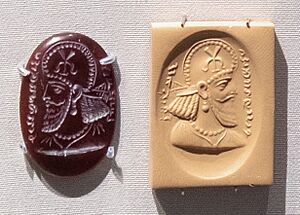
Nishapur was once known as Abarshahr during the Sassanid Empire. This was a large province with Nishapur as its capital. Abarshahr was a key place for trade and communication between different regions like India and China. Its governor had a special title called "kanarang."
Nishapur in the Middle Ages
Muslim Conquest and Growth
Nishapur was taken over by the Rashidun Caliphate without a fight. The city's leaders agreed to pay a tribute instead of fighting. Later, the city was divided, and after some disagreements among the Persian chiefs, the Muslim army entered and took control.
Abu Muslim became the governor of Greater Khorasan and made Nishapur his capital. He started many building projects, helping the city grow. Nishapur became very important, and two future caliphs (leaders) were governors here. The city's location on trade routes made it a valuable place.
Tahirid and Samanid Rule
The Tahirid dynasty, a Persian family, ruled Khorasan from 820 to 872. Nishapur became their capital from 828. Even though they were part of the Abbasid caliphate, they were mostly independent. Their power spread all the way to India.
Later, the Samanids took over. They also made Nishapur a major city. During this time, Nishapur was a busy trading hub. Merchants came from many places, including Iraq, India, Egypt, and even Russia.
Nishapur was a vital stop on the old Silk Road. This route connected places like Anatolia and China. The city got its name from its founder, King Shapur I, who started it in the 3rd century. The nearby turquoise mines have been supplying the world with beautiful stones for thousands of years.
Nishapur became very important again in the 9th century. Its beautiful glazed pottery was a popular trade item. For a while, Nishapur was as important as cities like Baghdad. In 1038, Toghrül, the first ruler of the Seljuk dynasty, made Nishapur his home and declared himself sultan there. However, the city faced challenges, including being attacked by the Oghuz Turks in 1154 and suffering from several earthquakes.
Mongol Invasion and Recovery
In 1221, a sad event happened. After the death of Tuqachar, the son-in-law of Genghis Khan, the Mongols completely destroyed Nishapur. Genghis Khan's daughter wanted revenge, so the Mongol troops killed almost everyone in the city.
After this terrible event, a much smaller town was built north of the old city. The old, busy city was buried underground. In the mid-20th century, a team from the Metropolitan Museum of Art started digging up the ancient ruins. Today, what's left of old Nishapur is a large protected area south of the modern city. This area is called "Kohandejh."
Later, during the Ilkhanate and Timurid times, people tried to rebuild Nishapur. The city's population grew again, and some villages were improved. Important buildings like the Mausoleum of Attar of Nishapur were built during this time. Many famous poets and scholars were also born in Nishapur during this period.
Modern Nishapur
Safavid Era (16th to early 18th century)
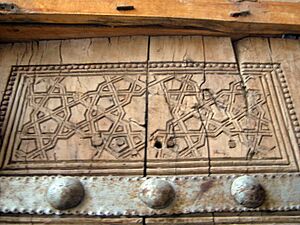
In the 16th century, Nishapur was involved in a conflict between Mohammad Khodabanda and his son Abbas the Great. This helped Abbas the Great become the ruler of Persia. In 1592, he took back control of Nishapur. The Shah Abbasi Caravanserai was built during his rule.
Pahlavi Dynasty and Modern Changes

The Mausoleum of Omar Khayyám was rebuilt in Nishapur by order of Reza Shah. The new monument, designed by architect Hooshang Seyhoun, became a symbol of the city and modern Persian architecture. The Tomb of Kamal-ol-molk was also built by Seyhoun.
In 2004, a train carrying dangerous goods derailed near Nishapur. This caused a huge explosion that destroyed many buildings and led to a tragic loss of life. It is known as one of the worst railway disasters.
Archaeological Finds
Not much archaeological work has been done in Nishapur, even though it's a huge and complex site. The Metropolitan Museum of Art did some excavations from 1935 to 1940. They found many items like ceramics, glass, and metalwork, which are now in museums around the world.
Shadiyakh was an important palace area in old Nishapur. Famous people like Attar of Nishapur lived there. Today, Attar's tomb is in this area, which was likely destroyed in the 13th century.
People and Language
What Languages Are Spoken?
Most people in Nishapur speak Persian. There are also schools that teach English and other languages.
How Many People Live Here?
In 2016, the population of Nishapur was about 264,375 people. It is the third most populated city in eastern Iran.
Nishapur's Location and Weather
Where is Nishapur?
Nishapur is located about 1,250 meters (4,100 feet) above sea level. It's on a wide, flat plain at the foot of the Binalud Mountains. The city is connected by roads and railways to major cities like Mashhad and Tehran.
What's the Weather Like?
Nishapur usually has a warm and semi-dry climate. Most of the rain falls in spring and winter. Because it's higher up than nearby cities, the weather in Nishapur is often milder and more pleasant.
| Climate data for Neyshaboor (1991–2010) | |||||||||||||
|---|---|---|---|---|---|---|---|---|---|---|---|---|---|
| Month | Jan | Feb | Mar | Apr | May | Jun | Jul | Aug | Sep | Oct | Nov | Dec | Year |
| Record high °C (°F) | 18.0 (64.4) |
24.2 (75.6) |
29.4 (84.9) |
33.2 (91.8) |
38.0 (100.4) |
41.4 (106.5) |
41.6 (106.9) |
42.8 (109.0) |
38.6 (101.5) |
33.6 (92.5) |
28.0 (82.4) |
24.2 (75.6) |
42.8 (109.0) |
| Mean daily maximum °C (°F) | 7.2 (45.0) |
10.1 (50.2) |
15.4 (59.7) |
22.1 (71.8) |
27.4 (81.3) |
32.8 (91.0) |
34.8 (94.6) |
33.8 (92.8) |
29.9 (85.8) |
24.0 (75.2) |
16.2 (61.2) |
10.1 (50.2) |
22.0 (71.6) |
| Daily mean °C (°F) | 1.8 (35.2) |
4.4 (39.9) |
8.9 (48.0) |
14.8 (58.6) |
19.3 (66.7) |
24.1 (75.4) |
26.1 (79.0) |
24.5 (76.1) |
20.3 (68.5) |
15.1 (59.2) |
9.0 (48.2) |
4.3 (39.7) |
14.4 (57.9) |
| Mean daily minimum °C (°F) | −3.5 (25.7) |
−1.4 (29.5) |
2.4 (36.3) |
7.5 (45.5) |
11.3 (52.3) |
15.3 (59.5) |
17.4 (63.3) |
15.3 (59.5) |
10.7 (51.3) |
6.1 (43.0) |
1.7 (35.1) |
−1.4 (29.5) |
6.8 (44.2) |
| Record low °C (°F) | −25.0 (−13.0) |
−22.0 (−7.6) |
−15.8 (3.6) |
−3.8 (25.2) |
−0.6 (30.9) |
6.8 (44.2) |
10.6 (51.1) |
3.6 (38.5) |
0.8 (33.4) |
−7.6 (18.3) |
−8.6 (16.5) |
−13.0 (8.6) |
−25.0 (−13.0) |
| Average precipitation mm (inches) | 34.8 (1.37) |
35.8 (1.41) |
57.1 (2.25) |
31.9 (1.26) |
19.3 (0.76) |
5.5 (0.22) |
1.4 (0.06) |
0.0 (0.0) |
1.1 (0.04) |
3.6 (0.14) |
18.0 (0.71) |
29.7 (1.17) |
238.2 (9.39) |
| Average relative humidity (%) | 72 | 67 | 61 | 55 | 45 | 32 | 29 | 28 | 33 | 43 | 58 | 71 | 50 |
| Source: Iran Meteorological Organization [1] | |||||||||||||
Earthquakes in Nishapur
Nishapur is in an area where earthquakes can happen. Many earthquakes have caused serious damage to the city throughout its history, especially in the 12th and 13th centuries.
Nishapur's Economy
Nishapur has a varied economy, meaning it relies on many different things. These include farming, factories, mining, tourism, healthcare, and banking.
Farming and Food
Nishapur County grows many farm products. These include saffron, grains, cotton, herbs, plums, walnuts, apples, cherries, and pistachios. The city also produces dairy products and sugar. Most of the city's water comes from the Binalud Mountains, rivers, and wells.
Mining and Energy
Nishapur is known for its natural resources like turquoise and salt, which are mined nearby. The city gets its electricity from a power plant and a wind farm.
Industry and Tourism
Large industrial areas like the Khorasan Steel Complex and the Khayyam and Attar Industrial Parks are close to Nishapur. They produce things like sugar and cooking oils.
Nishapur also has a growing tourism industry. There are hotels, resorts, parks, museums, and historical sites. These include mausoleums and old mosques. The city has a lot of potential for more tourism.
Getting Around Nishapur
Roads and Trains
The main national road, Road 44, connects Nishapur to Tehran and Mashhad. Nishapur is also part of the Trans-Iranian Railway System, which is a UNESCO World Heritage Site. The train station is in the southern part of the city.
Public Transportation
The city has a bus station and several public bus lines to help people get around.
Airport
Currently, there is a small airport near the city for gliders and small planes. However, there are plans to build a larger airport in the future.
Famous People from Nishapur
Nishapur has been the birthplace or home to many important people throughout history. Here are a few:
- Omar Khayyam (1048–1131) – A famous Persian thinker, mathematician, astronomer, and poet.
- Attar of Nishapur (c. 1145 – c. 1221) – A well-known Muslim poet and mystic.
- Abū al-Wafā' Būzjānī (940–998) – A brilliant mathematician and astronomer.
- Abū-Sa'īd Abul-Khayr (967–1049) – A famous Persian Sufi (mystic) and poet.
- Muslim ibn al-Hajjaj – A very important Muslim scholar.
- Mohammad-Reza Shafiei Kadkani (born 1939) – A modern Persian writer, poet, and critic.
- Parviz Meshkatian – A well-known musician.
Culture and Traditions
Beliefs and History
Nishapur has a rich history of different beliefs. Before Islam, Zoroastrianism was the main religion. An important Zoroastrian fire temple was located in the mountains of Nishapur. After Islam spread, most people in Nishapur became Muslims.
The city has also been important for Sufism, a mystical practice in Islam. Poets like Attar of Nishapur had a big impact on Sufism. Nishapur was also a center for Isma'ilism, a branch of Islam.
Pottery and Art
During the Islamic Golden Age (especially the 9th and 10th centuries), Nishapur was a major center for making beautiful pottery. Many of these old ceramic pieces are now in museums. Nishapur pottery often used bright colors and bold patterns, including geometric designs, plants, and even animals.
A selection of these discoveries is shown in the gallery below:
-
Bowl painted on slip under transparent glaze (polychrome), Nishabur, 9th or 10th century. National Museum of Iran, Tehran.
-
Bowl with Kufic Inscriptions found in the archeological excavations of Nishapur. The Middle East Institute's logo has been inspired by this bowl. This bowl is currently held in the Met.
-
Pottery of Nishapur in the Islamic Golden Age (10th - 11th century)
-
Pottery of Nishapur in the Islamic Golden Age (10th - 11th century)
-
Pottery of Nishapur in the Islamic Golden Age (10th - 11th century)
-
Pottery of Nishapur in the Islamic Golden Age (10th - 11th century)
-
Cup with votive inscriptions in Kufic script. Terracotta, slipped decoration on slip, underglaze painted. 10th-11th century, Nishapur. Metropolitan Museum of Art
Nishapur's Anthem
Nishapur has its own special anthem, which was first shown in 2011. It tells the story of the city, including its difficult times and its beauty.
| Persian original | Romanization | English translation |
|---|---|---|
|
|
|
Literature and Music
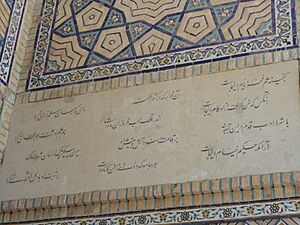
Nishapur is often mentioned in Persian literature because of its beauty and gardens. Many famous Persian poets, like Omar Khayyam and Attar of Nishapur, were born here. Even foreign writers have written about Nishapur.
Music in Nishapur has been shaped by different styles over time. It's part of the Khorasani Folk Music. Famous musicians from Nishapur include Parviz Meshkatian. You might also know the song "Incident at Neshabur" by the band Santana or "Blue as the Turquoise Night of Neyshabur" by Yo-Yo Ma.
Sports and Games
Nishapur has sports facilities, including an indoor arena for basketball, volleyball, and futsal. The city even has a professional football team. Nishapur was supposed to host a big international scouting event in 1979, but it was canceled.
Local Celebrations
Nishapur celebrates many local and cultural days throughout the year. These include:
- Nowruz (Farvardin 1) – The Persian New Year.
- Respect day for Attar of Nishapur (Farvardin 25).
- Respect day for Omar Khayyam (Ordibehesht 28).
- Night of Yalda (Azar 30) – The longest night of the year.
- Chaharshanbe Suri Festival (Last Wednesday of Esfand) – A fire festival before Nowruz.
Food and Local Delights
Some of the most important local foods and drinks in Nishapur are made from rhubarb. This sour vegetable grows in the nearby mountains. You can find refreshing drinks made from rhubarb, like sharbate rivaas. Another local dish is Aush Komay, a type of soup.
Carpets and Turquoise
Nishapur is famous for its beautiful carpets and rugs. Many villages in the area have workshops where these carpets are woven. Some of the biggest carpets in the world have been made in Nishapur, for places like the Sheikh Zayed Grand Mosque.
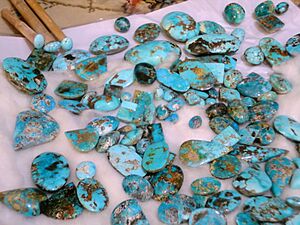
For thousands of years, Nishapur has been a key source of turquoise. This beautiful blue stone was originally called "pirouzeh" in Persian, meaning "victory." Nishapur is sometimes called the "city of turquoise." The turquoise mines are about 50 kilometers northwest of the city.
Buildings and Monuments
Nishapur has many historical buildings and monuments. Some of these are shown in the picture box at the top of this article. Here are a few more:
-
Lak Lak Ashian Castle (Qajar Iran 19th century). Part of the national heritage list of Iran.
Education in Nishapur
Schools and Universities
Nishapur has several high schools, including the famous and oldest Omar Khayyam High School. For higher education, there are several universities and colleges, such as the University of Neyshabur and the Islamic Azad University of Neyshabur.
Media and News
Local Newspapers
Nishapur has local newspapers that are published weekly. The first local newspaper in the region was Morning of Nishapur, which started in 1989. Other papers include Shadiakh and Khayyam Nameh.
Sister Cities
Nishapur is "twinned" with several other cities around the world. This means they have special friendly relationships and often share culture and ideas.
See also
 In Spanish: Nishapur para niños
In Spanish: Nishapur para niños


